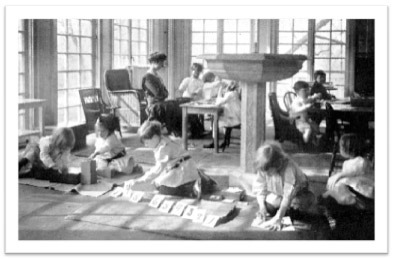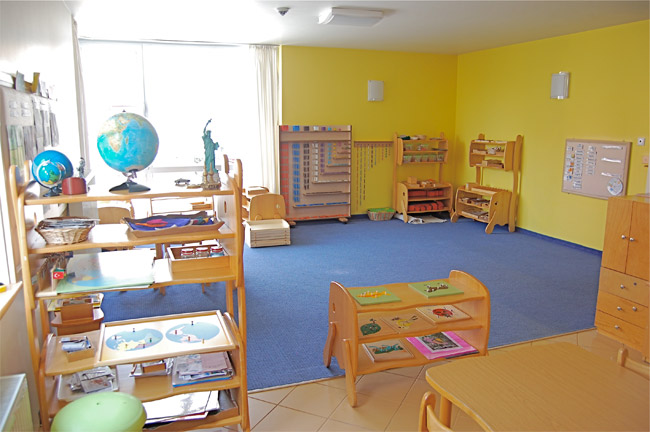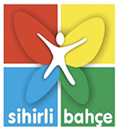 The Prepared Environment
The Prepared Environment
The child’s first steps are the turning point in his/her development. His/her static situation becomes active. This is the beginning of a period that is sensitive to movement. Montessori thinks that the movements of the child serve for a purpose. The aim is to be able to dominate over the whole body. As a result, mind and body can build an effective correlation. Depending on this idea Montessori thought that the children was moving according to an aim and this aim was the acquisition of information that they need for their development. Obviously, this was a kind of information that could only be acquired by movement. The activities of children are never accepted as mere play but denominated as WORK in the Montessori Method.
In the first years of the life, the transmission of information in a verbal way is not possible because the rudimentary knowledge is still incomplete. The space and the time concepts are not inborn knowledge. They are acquired through concrete experience. The acquisition of space concept is possible by movements of the body where brain explores and perceives the space. The time concept is learned by the perception and alignment of change. In addition to those concepts, the children don’t have the conceptions that express classification, alignment, quality and quantity. So, the child has so much to experience.
The acquisition of those concepts is possible only if the concept is designed and presented in a concrete form and open to the child’s experience. Therefore, for the child the acquisition of the information is possible only through the concrete experiences gathered form the environment. In other words, he/she can acquire the information that will serve for his/her development from the environment by means of the experience of his/her body movements and sensorial organs. This is how the brain is developed and the preconditions of learning are provided.
In a prepared environment everything suits with the child’s dimensions. Thus, the child has a full freedom of movement and action in the environment. By this way, he/she can manipulate and use the environment according to his/her will. And when the child uses the environment without the assistance of an adult, the feeling of being self-sufficient develops and gets stronger in time. As a result, the child becomes an independent individual in time.
Order of the Environment
The understanding of order emphasized in the Montessori Method is totally different from the order concept which is generally used. To be in order for the widely used form means to be well organized whereas for the children the order is the relation between the objects in the environment. This is the most efficient way for children to acquire and learn the functions of the objects as a whole. A number of forks that stand in a cabinet doesn’t give information to the child about understanding the function of the fork, whereas the fork next to a plate on a table gives a clear information about its function. In a Montessori school all materials are placed according to a certain order and functionally each material is in relation with other surrounding materials. Organization of the writing and reading tools in a certain way can be given as an example about the functional order. Besides, the places of the tools aren’t changed, thus the children take the materials which they want to study from the same place and place them to the place where they took the material. Fixed places for the materials provide opportunity to the child for repetition of the work with the same material and he forms a mental image of the concrete curriculum in his mind so that he can move towards advanced concepts.
The order supports the child’s confidence towards the newly met environment. And develops an efficient control over his environment with clarity.

“Plainly, the environment must be a living one, directed by a higher intelligence, arranged by an adult who is prepared for his mission.”
Maria Montessori
At the Montessori Method, the environment is consisted of six major components:
- Freedom: To develop into a self-sufficient individual the child must be in a free environment. Therefore, the child should be set free within the defined rules. Freedom is accepted as a very important aspect of the Montessori Method.
- Structure and Order: Being in an environment that is designed according to a curriculum with a definite and unchangeable order is a key for the child to develop the concept of space and relation. The child is born into an environment filled with a vast variety of stimulators. By the Montessori structure and order principles, the children begin to perceive the extreme variety in an order.
- Realism and Nature:The materials in the classrooms are actual household goods (like glass or ceramic bowls, washbasin, jars and glasses). By this means, the child gets the exact information about the real world (i.e. if the ceramic falls down, it is broken).The responsibility of the animals and plants in the classrooms and in the garden belongs to the children. By this means, they learn the differences between the living being and non-living things. And definitely they develop an idea about the functioning of the nature.
- Beauty:The beauty comes from the simplicity of the environment.“The child should live in an environment of beauty.” Maria Montessori
- Ambiance: The atmosphere of the classroom must reflect the purposefulness and productivity of the environment.
- Montessori Materials: The Montessori Materials are designed in such a manner that will attract the long-term attention of the child. Through the child’s concentration moments, the materials transform the child’s cognition. After a hundred years of practice, these materials are accepted as the works of a genius.


 Türkçe
Türkçe